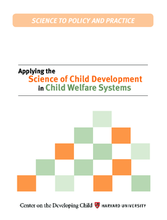Part I of this paper describes the science behind the development of a child's brain, the impact of toxic stress on the developing brain, and how protective factors build resilience and moderate the toxic stress response. Part II offers suggestions to strengthen the child welfare system and improve outcomes for children involved with the system based on the developmental science research presented in Part I. The paper identifies three ways to improve outcomes for children as well as how they translate into informed systemic action: 1.) reduce external sources of stress; 2.) develop responsive relationships; and 3.) strengthen core life skills.
Introduction
The healthy development of all children is essential for a thriving and prosperous community, and we now know a great deal about how child development works, as well as how to prevent and address problems. In publications over the past decade, the Center on the Developing Child and the National Scientific Council on the Developing Child have sought to explain the ways in which infants and young children acquire a strong foundation for lives of health, learning, and well-being; how adversity disrupts healthy development; and how to build resilience.
How can we use these insights from cuttingedge science to improve the well-being and long-term life prospects of the most vulnerable children in our society? This is both a critical challenge and a powerful opportunity to affect the trajectories of millions of children in the United States and around the world. It is a question of particular importance to those who make, or seek to affect, public policy—from elected officials to leaders of a wide range of public systems such as education, health care, and income support.
In this paper, we show how the science of child development can be leveraged to strengthen one of these public systems: child welfare. Our intended audience includes leaders in the public agencies responsible for child protection and related functions; in the private, non-profit agencies that provide many of the services in these systems; in the courts, which play a critical role in child welfare; in legislative committees that oversee child welfare and related services; and in the many other public systems, such as early childhood education, mental health, and juvenile justice, whose support is essential to success in child welfare. While this paper is focused on child welfare systems in the United States, we believe it may be relevant to other countries with similar systems. Leaders in these areas have the unique opportunity to both drive changes in child welfare policy and practice and model the kinds of actions, from front-line workers and parents, needed to promote healthy child development. We hope the paper will be equally valuable to front-line practitioners and supervisors, who are the essential deliverers of effective child welfare services.

